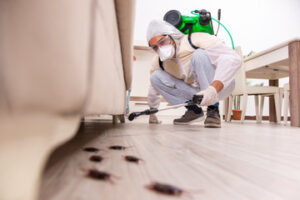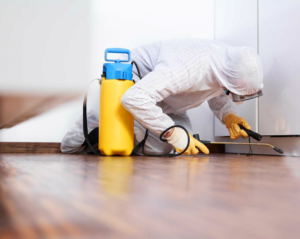Pest Control Malibu involves preventing or eliminating unwanted organisms. This includes insects, rodents, and other organisms that damage plants or cause other harm.
Most pesticides are designed to affect only the target organism. However, other organisms may also be harmed by the chemicals or their residue.

Look for a company that focuses on the pest you have and uses chemicals with low risk of harming other organisms. Also, ask about their training and certifications.
Prevention
Preventive pest control is any strategy that seeks to prevent the occurrence or growth of unwanted organisms. Preventive steps can be very effective in reducing the need for pesticides. For example, keeping indoor areas free of food scraps and clutter can drastically reduce the occurrence of rodent pests such as ants and mice. Regular cleaning and prompt disposal of garbage can also decrease the likelihood of attracting insects such as flies and cockroaches.
The weather can influence the activity and numbers of some pests. For instance, some plant-eating pests are influenced by the amount of sun and shade they receive. Climate can also affect the ability of a disease to spread from one plant to another. Preventive measures might be as simple as altering the amount of water in an area or using fertilizers that are slow to break down.
Insects and mites that feed on plants or humans can be controlled by natural predators and parasites. In addition, some organisms can be used as biological controls in the form of sterilisation programmes.
Chemical pesticides may be necessary for some situations, but IPM emphasizes non-chemical and low-toxicity controls whenever possible. For example, traps, baits and physical barriers such as fences can be used in the early stages of a pest problem to remove or deter infestations before they become serious. The use of sonic devices to disrupt the mating habits of some pests can also be effective.
Before resorting to chemical control methods, it is important to determine the severity of a pest infestation. It is also a good idea to understand the habits of the pest in question. For example, knowing that a particular insect only breeds during certain times of the year can help in determining whether the situation can be tolerated until the breeding cycle ends.
An effective preventive program might include a detailed inspection of the outside and inside of a building to identify entry points and potential attractants. These areas should be sealed, as should any cracks or crevices. A schedule should be established for checking and repairing any seals that need to be replaced. Moisture problems should be corrected, as many pests thrive in wet environments. Drainage systems should be kept in good repair, and gullies should be capped to prevent sewer rat infestations. Door sweeps and tight-fitting screens can prevent many flying pests from entering a home.
Suppression
Pests are organisms that cause unacceptable damage to crop plants, livestock, structures, landscape trees and shrubs, weeds, or vertebrate animals. They also disrupt soil health, water quality and availability, displace desirable species, and adversely affect terrestrial and aquatic ecosystems (EPA 2014).
Preventive methods are economical, environmentally responsible, and keep pest populations below damaging levels. They include regularly cleaning or removing objects where pests may live, and using barriers to prevent pest access. Barriers include netting and screening in greenhouses to prevent insects that cause plant loss; putting down a layer of mulch to inhibit weeds; or installing termite, insect, or bird barriers such as spikes, owl houses, or grid wires.
Suppression methods are used when pests have already exceeded a threshold level and need to be controlled quickly. They include utilizing biological control agents, chemicals, and physical barriers. Biological control agents are natural enemies of the pest (predators, parasites, and predatory arthropods) that reduce the pest population through direct contact or indirect means. Examples of biological control agents include nematodes, bacteriophages, and plant-parasitic fungi. Chemicals such as pyrethrins, azadirachtins, and spinosads are also commonly used pesticides.
If prevention and suppression fail to keep pest populations below damaging levels, eradication methods may be necessary. This involves destroying the entire population of the pest in a targeted area. Eradication is primarily used for very serious pest problems that threaten human health or the environment.
The most common way to eliminate pests is through a combination of control techniques. Pests generally respond to different controls in a predictable manner. Frequently removing breeding sites can help deter some pests, as can spraying with the bacterial product Bacillus thuringiensis var. kurstaki, which releases the molecule lysophosphatidylcholine that breaks down an insect’s cell walls and kills it.
The most important practice homeowners can do to encourage natural enemies in their landscape is to provide them with suitable habitats and conditions. This is called conservation biological control and is done through changes in land management practices, such as reducing use of pesticides, providing suitable food for natural enemies, and limiting available water for pests. Augmentative biological control is a similar process, but uses mass-produced biological control agents that have been raised in insectaries and released in the field to augment the number or effectiveness of local natural enemies.
Eradication
In some instances, pests are so persistent that they need to be eradicated. This is a rare goal in outdoor pest situations; most of the time, prevention and suppression are better goals. However, in enclosed areas, such as homes; schools; offices; health care facilities; and food preparation and storage areas; eradication is often the aim. Examples include cockroaches; ants; rodents; and bed bugs.
A professional pest control technician is an expert in methods to stop these creatures from getting inside the building and causing damage or creating health problems for people who live or work there. They can also advise the best methods to keep these pests from entering and breeding in the first place, by limiting food, water, shelter, and other resources that they need.
To prevent pests from gaining entry to your home, check for cracks and crevices where they can enter and hide. Use caulk or put in metal wool to seal these gaps. You should also weather strip doors and windows and repair any screens that are torn or damaged. It is also important to clean up crumbs and other food sources around the house and to store any foods in sealed containers. Also, eliminate access to water by putting in drain screens over sinks and bathtubs.
Once you’ve taken preventive measures, and waited for a few weeks to see if the pests have gone away on their own, then you may want to try baits. These are chemical pest control substances that poison the pests and can be a very effective tool in preventing pests, especially in conjunction with physical traps. Only a qualified pest control technician should have access to and use these chemicals, as they are incredibly toxic to humans if ingested or inhaled. Some examples of these chemicals are pyrethrins, carbaryl, and permethrin. They are also used in combination with trap crops, such as zinnias, that lure the pests into a location where they can be killed or trapped. This type of pest control can be used in both residential and commercial settings. It can also be used in the outdoors, on crops or in natural areas to manage certain pests.
Monitoring
Pest monitoring is an important part of an IPM pest control program. This scouting, checking and identification activity lets you know what pests are present, where they are living and what damage they’re causing. By using this information you can better set action thresholds. This ensures that you don’t take action on the wrong kind of pest, that pesticides aren’t used when they aren’t needed, or that you don’t fail to act because you weren’t able to see any problem.
The monitoring process is most effective when it’s done on a continuous basis, as opposed to occasional scouting and inspections. Pests can be found in all sorts of places inside a facility or structure, making it difficult to identify them all. To help find them, your pest management professional will use a variety of tools including a flashlight. This allows them to see in dark harborage areas such as corners and crevices where pests may be hiding, and it also helps with inspecting rodent bait stations or insect light traps. An extendable mirror is another useful tool for getting behind equipment and other hard to reach spaces where pests often hide. A magnifier is also useful for identifying and inspecting pest parts, frass (excrement) or other evidence of infestation.
These tools are combined to produce a detailed pest activity report which includes a written description of the observed pest activity, a record of the type of device inspected and the number or percentage of devices inspected that had pest activity along with data about which devices were skipped and what types of pests they were. The data can then be trended over time to identify trends and determine if the levels of pest activity are decreasing or not.
In some situations, such as when a pest threatens to destroy valuable collection objects or to create an unacceptable level of damage, eradication is the goal. In other situations, such as when a pest is not causing harm, it may be possible to tolerate a certain level of pests, but this must be evaluated on a case by case basis.


